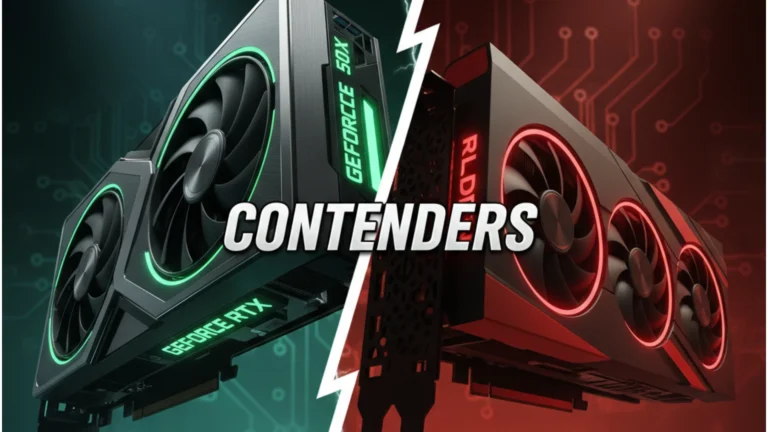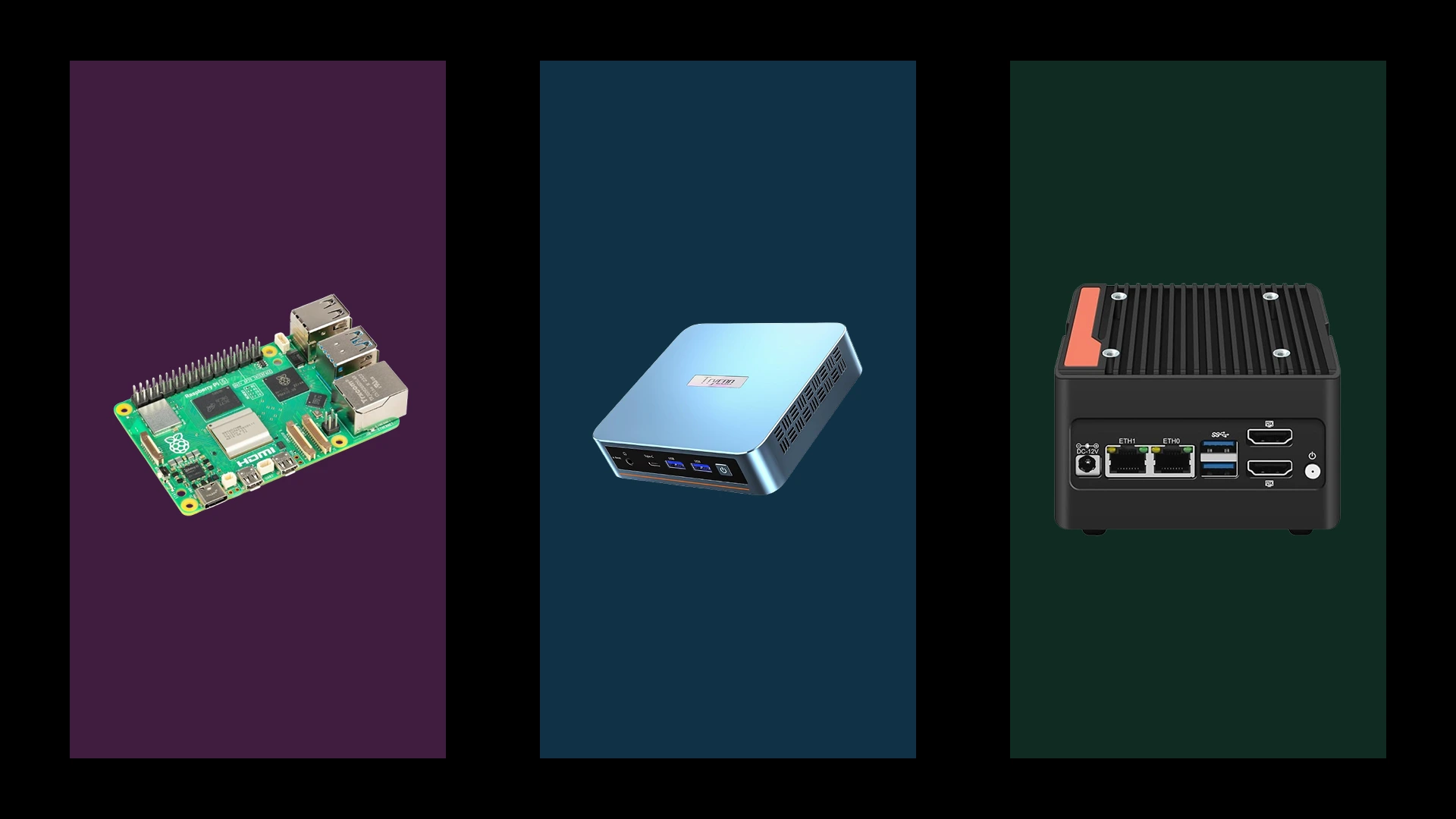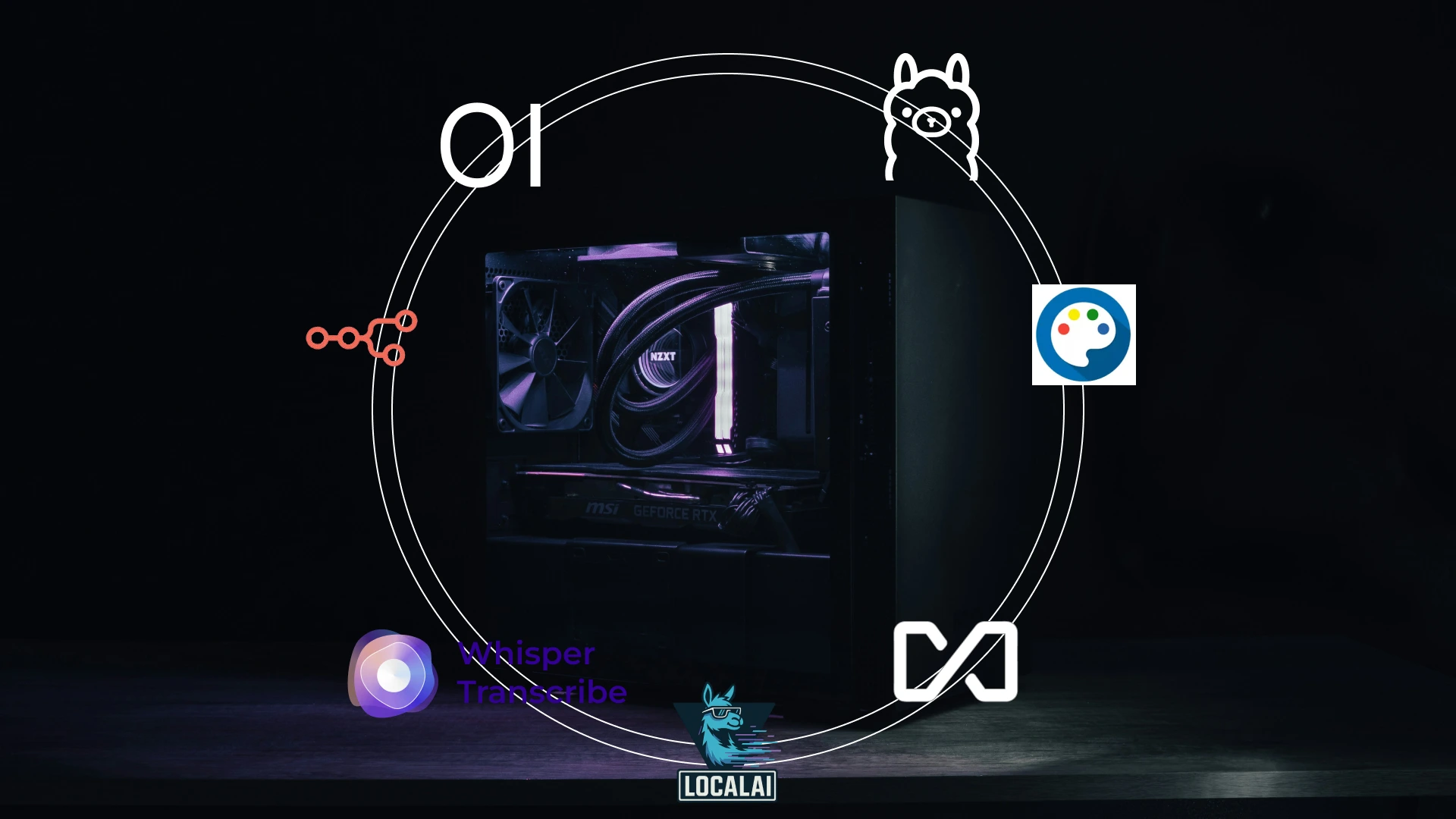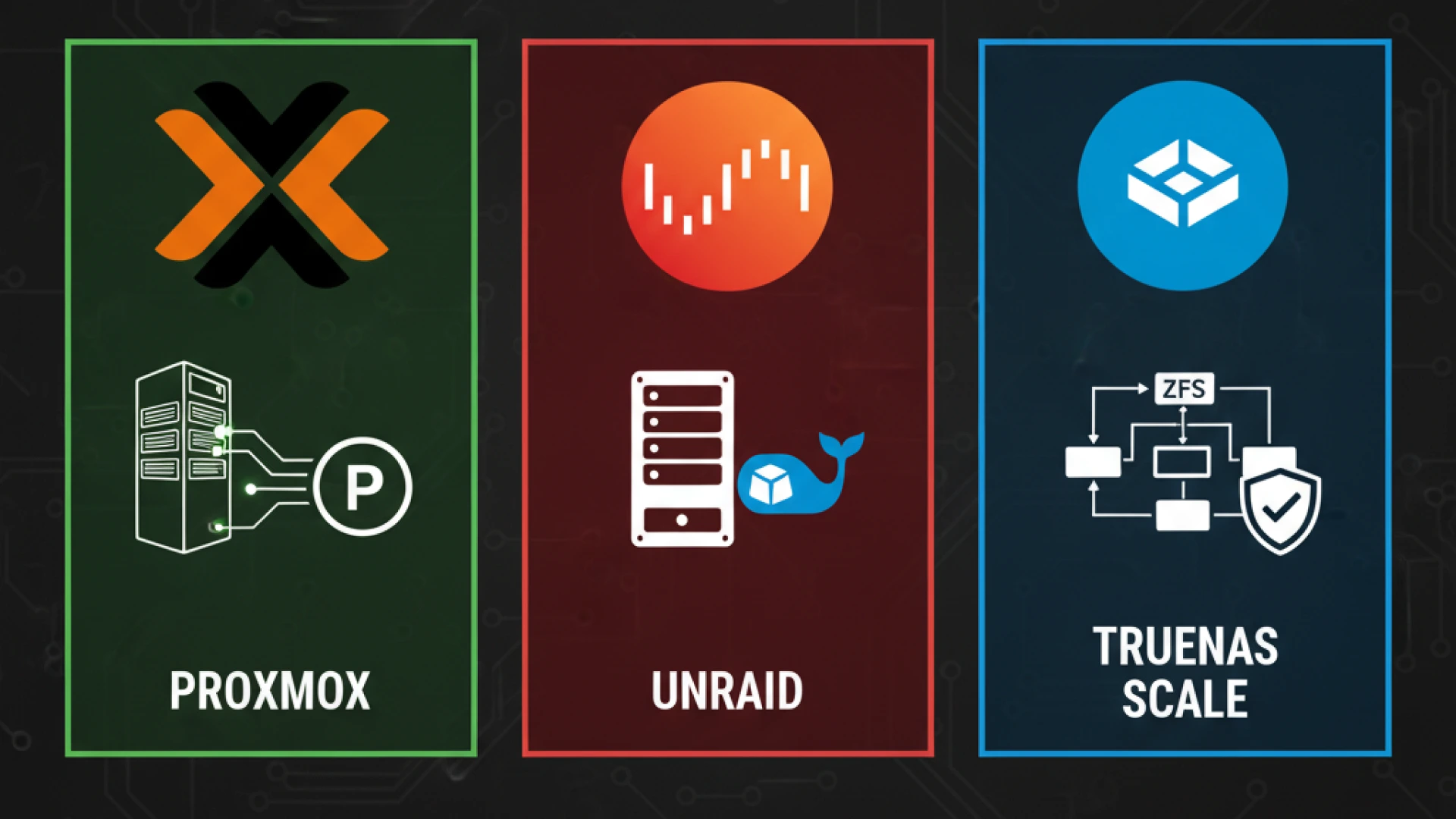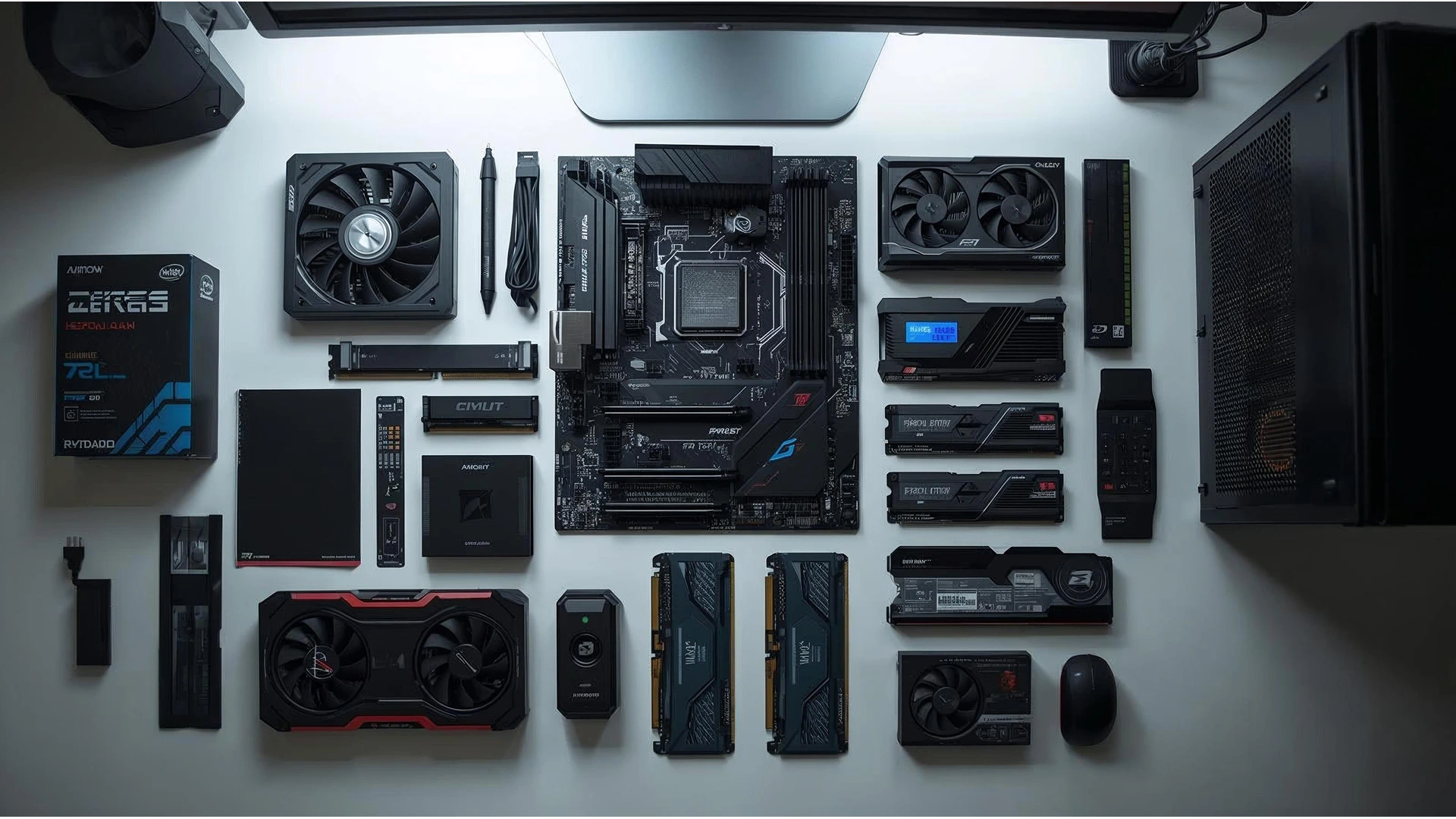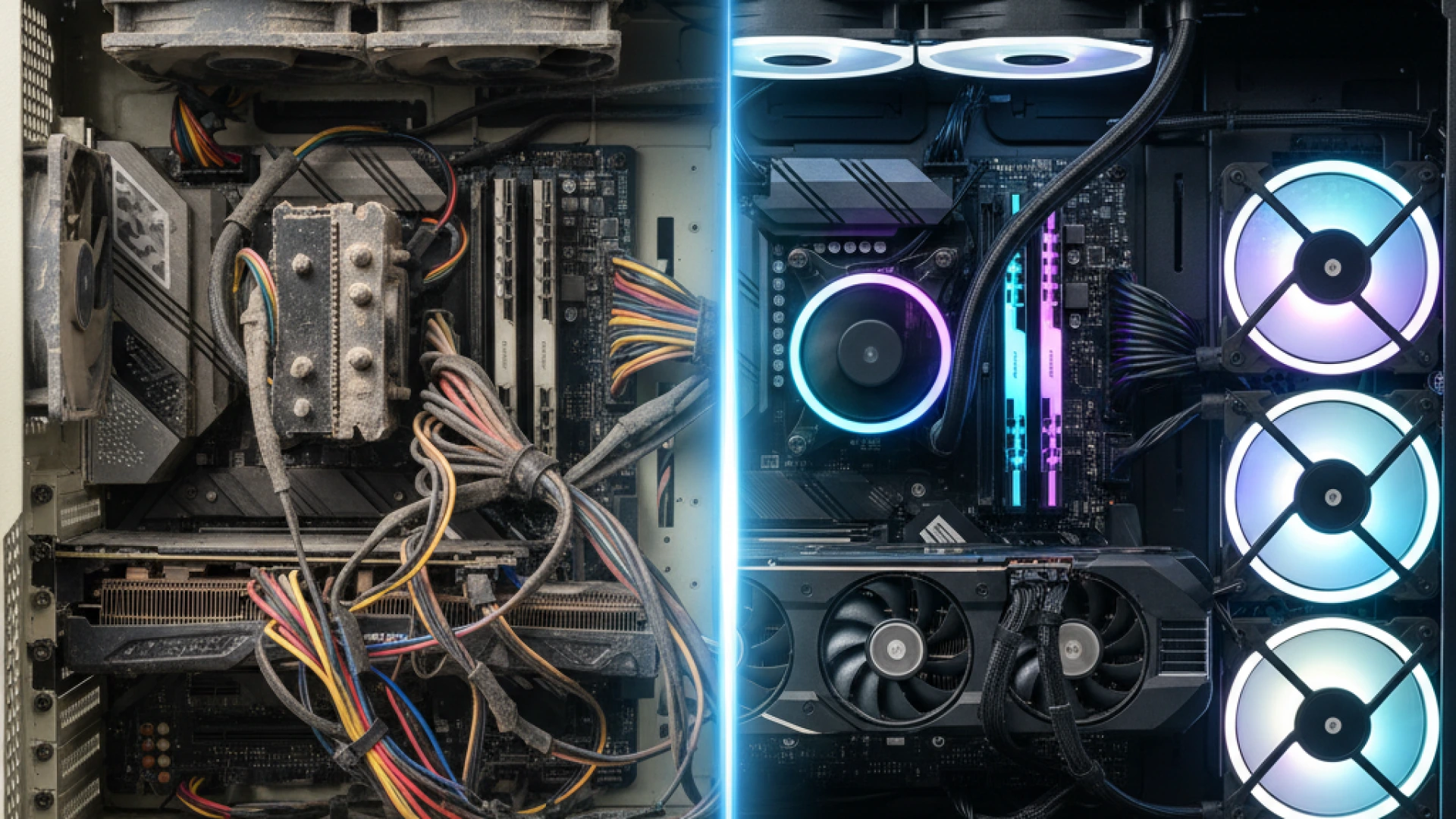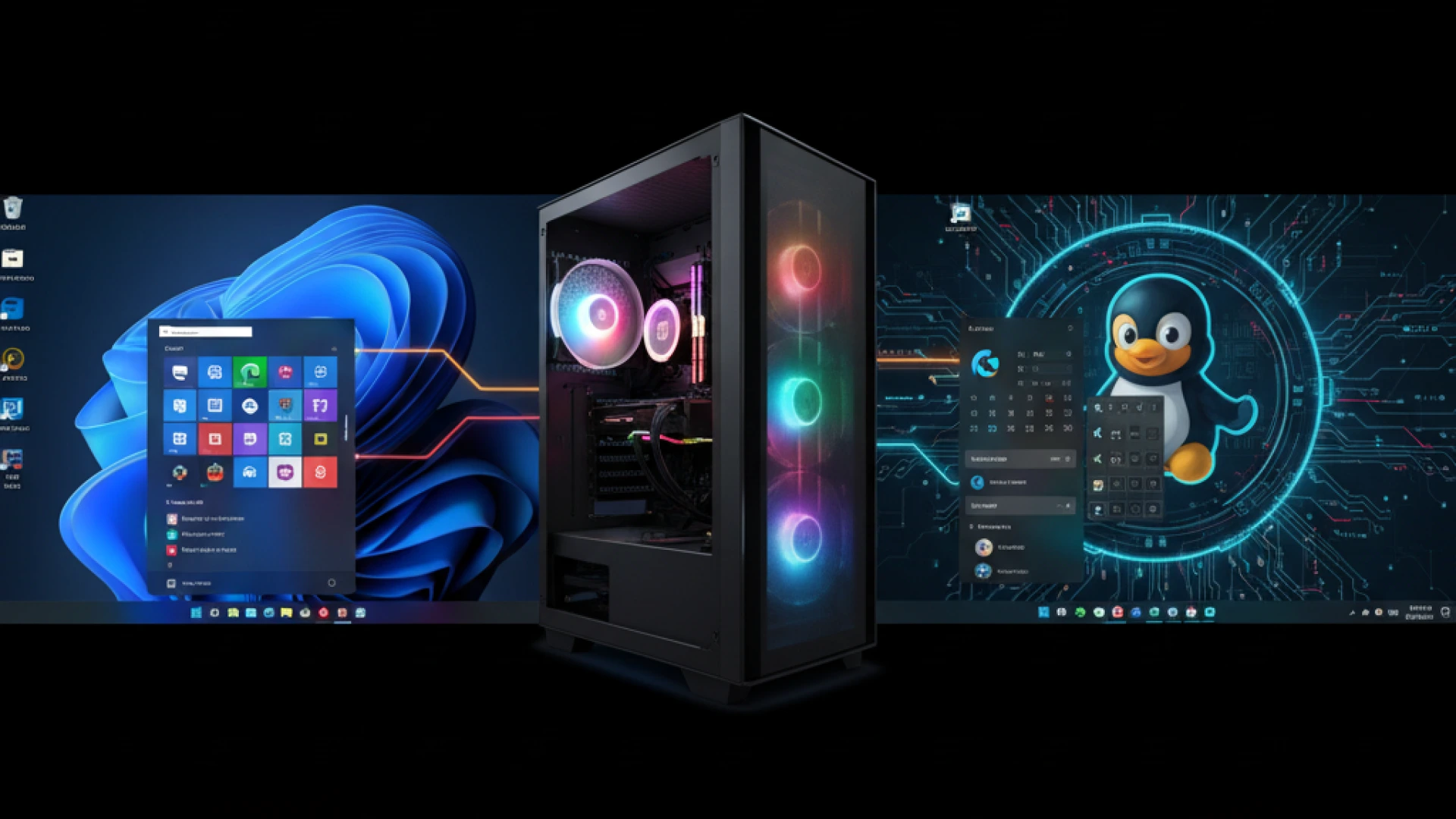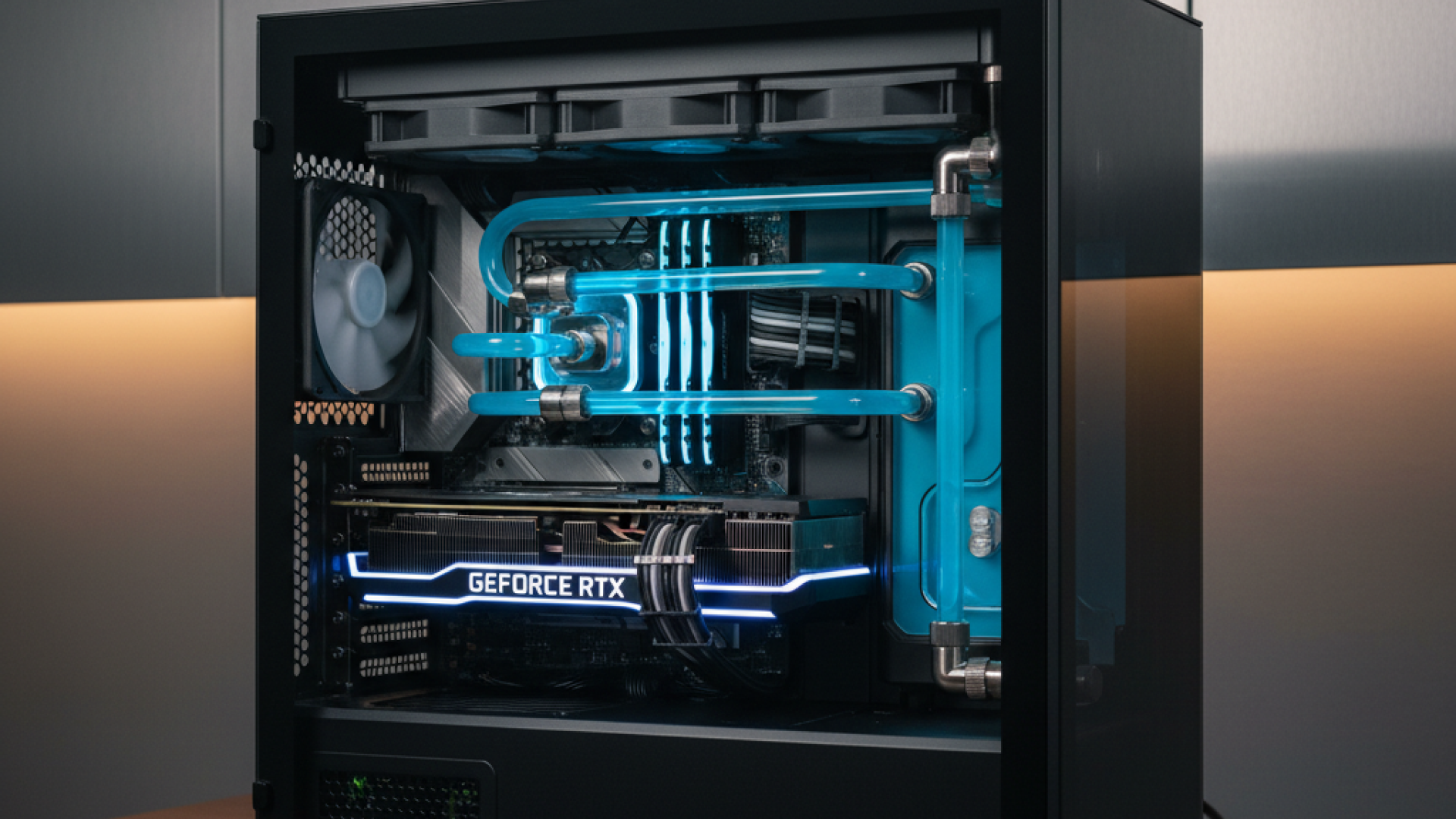The next-generation GPU battle in 2025 is defined by a strategic clash between two technological titans: NVIDIA’s GeForce RTX 50 Series, built on the new Blackwell architecture, and AMD’s Radeon RX 9000 Series, powered by the refined RDNA 4 architecture. This contest, Blackwell vs RDNA 4, represents more than a simple product cycle refresh; it is a fundamental shift in how graphics processors handle everything from real-time rendering to artificial intelligence, setting the stage for a data-driven analysis of performance, features, and value.
The stakes in this competition are immense. We are in the midst of a full-blown ray tracing revolution; what was once a niche feature is now a standard expectation, compelling both manufacturers to deliver dramatic performance improvements. AMD’s RDNA 4 introduces 3rd-generation Raytracing Accelerators, claiming over 2x the raytracing throughput per compute unit compared to its previous generation. NVIDIA counters with its own 4th-generation RT Cores, designed to handle increasingly complex geometry and lighting for hyper-realistic scenes.
Simultaneously, AI-powered gaming has cemented itself as the new frontier, fundamentally transforming how games are played and experienced. NVIDIA’s DLSS 4 leverages Multi Frame Generation (MFG), a feature exclusive to the RTX 50 series that can insert multiple AI-generated frames to boost smoothness dramatically. AMD’s response is the new ML-powered FidelityFX Super Resolution 4 (FSR 4), which uses the enhanced AI accelerators in RDNA 4 to deliver substantial image quality improvements and performance boosts in a growing library of games.
This analysis moves beyond marketing claims to provide a clear, data-driven examination of what these competing platforms genuinely offer. By leveraging comprehensive testing data from trusted sources, including Tom’s Hardware, Gamers Nexus, and IgorsLab, we dissect the architectural innovations, benchmark real-world performance, and evaluate the practical impact of their AI-powered features to answer the fundamental question for 2025: Does your next GPU prioritize NVIDIA’s cutting-edge ray tracing and DLSS 4, or AMD’s exceptional value and rasterization performance? Our goal is to determine which platform offers superior value for different users, providing the essential insight needed to navigate the competitive GPU market.
Architectural Showdown: Blackwell vs. RDNA 4
The battle between NVIDIA and AMD has reached a new pinnacle with their latest GPU architectures. NVIDIA’s Blackwell architecture and AMD’s RDNA 4 architecture represent fundamentally different approaches to solving the same challenges: delivering exceptional gaming performance, AI acceleration, and efficient ray tracing. Understanding the GPU specs and architectural innovations of each platform is essential for making an informed purchasing decision.
NVIDIA Blackwell Architecture: Neural Rendering Powerhouse
The Blackwell architecture introduces targeted advancements through its 4th-generation RT Cores and 5th-generation Tensor Cores, engineered for neural rendering and real-time ray tracing. These streaming multiprocessors are designed to enhance performance in complex lighting scenarios. The RT Cores feature a new Triangle Cluster Intersection Engine for handling detailed geometry, while the 5th-gen Tensor Cores are the backbone of AI features like DLSS 4, supporting new FP4 and MXFP4 data types for more efficient AI computations.
Built on the TSMC 4N process technology, Blackwell GPUs leverage cutting-edge GDDR7 memory, providing the massive bandwidth required for high-resolution gaming. This power does come with a significant energy demand. While the exact TDP for flagship models is not confirmed in the search results, the architectural focus on increasing core counts and clock speeds suggests high power consumption, necessitating robust cooling solutions for high-end models.
AMD RDNA 4 Architecture: Efficiency Through Innovation
AMD’s RDNA 4 architecture represents a comprehensive architectural overhaul focused on efficiency and practical performance gains. Manufactured on the TSMC 4nm process node (specifically N4P), it delivers competitive performance with notable power efficiency, especially in multi-monitor setups.
The architecture’s significant innovations lie beneath the surface. RDNA 4 introduces a redesigned memory subsystem, which includes an 8 MB L2 cache (the largest in the RDNA series to date) and improved compression techniques to reduce bandwidth requirements and latency. This is complemented by architectural improvements like Dynamic Register Allocation, which improves compute unit efficiency by intelligently distributing register resources based on workload demands. Furthermore, the scheduler in the Workgroup Processor no longer suffers from false memory dependencies between waves, allowing for better hardware utilization.
AMD’s 3rd-generation Raytracing Accelerators deliver over 2x the ray tracing throughput per compute unit compared to RDNA 3, while the 2nd Gen AI Accelerators enhance FSR 4 and the HYPR-RX suite, offering up to 8x the INT8 throughput per AI accelerator for sparse matrices. Though RDNA 4 GPUs utilize GDDR6 rather than GDDR7, the enlarged L2 cache and 64 MB of Infinity Cache help bridge the bandwidth gap, providing a cost-effective solution that doesn’t sacrifice performance in real-world gaming scenarios.
Quick Comparison Table
| Feature | NVIDIA RTX 50 Series (Blackwell) | AMD RDNA 4 GPUs (RX 9000) |
|---|---|---|
| Architecture | Blackwell | RDNA 4 |
| Process Node | TSMC 4N | TSMC 4nm (N4P) |
| RT Cores | 4th Generation | 3rd Generation Raytracing Accelerators |
| AI Cores | 5th Gen Tensor Cores | 2nd Gen AI Accelerators |
| Memory | GDDR7 | GDDR6 (complemented by Infinity Cache) |
| Key Innovation | DLSS 4 / AI-powered features | HYPR-RX suite with FSR 4 |
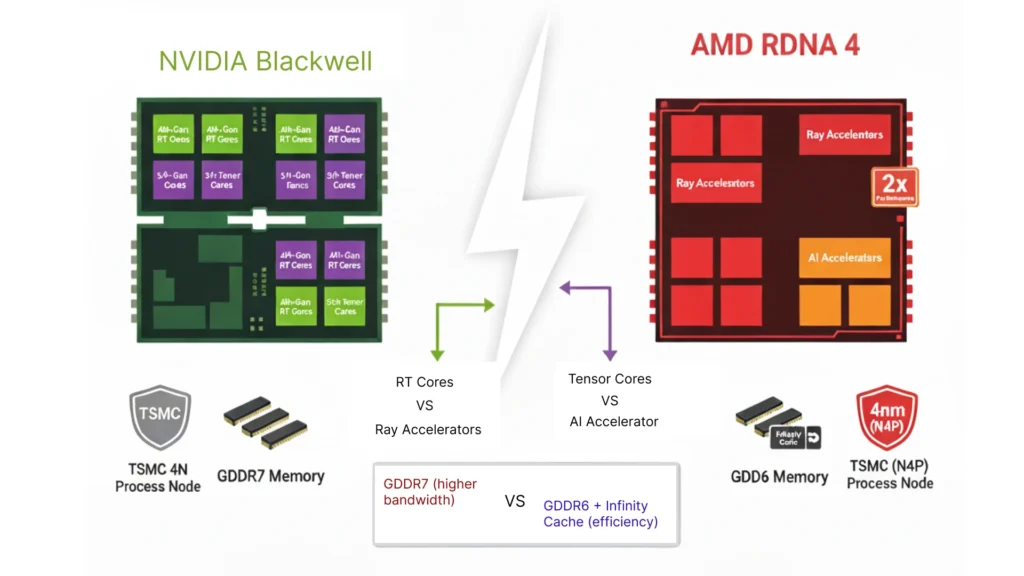
The Ray Tracing Battle: Hardware Meets Photorealism
Ray tracing performance has become the defining battleground for modern GPUs, fundamentally transforming how games render lighting quality, reflections, and shadows. Both NVIDIA and AMD have invested heavily in hardware ray tracing capabilities, but their architectural approaches differ significantly. Understanding these differences is crucial for gamers who prioritize visual fidelity in an increasing number of titles that leverage real-time ray tracing and the more demanding path tracing technologies.
NVIDIA’s Ray Tracing Approach: The Path Tracing Pioneer
NVIDIA’s 4th-gen RT Cores represent the current gold standard in dedicated ray tracing hardware, delivering unmatched performance, especially in path tracing scenarios. These cores are designed to execute the computationally intensive Bounding Volume Hierarchy (BVH) traversal and ray-triangle intersection tests at speeds impossible for traditional shader cores, offloading this work from the rest of the GPU. This dedicated hardware is the engine behind playable frame rates in fully path-traced games like Cyberpunk 2077: Overdrive Mode and Minecraft with RTX, which simulate complex light bounces for unparalleled realism.
A key innovation bolstering this performance is advanced BVH compression and compaction. By reducing the memory footprint of the acceleration structures that define the game world, this technology can save significant VRAM, potentially hundreds of megabytes in complex scenes. This efficiency is critical for real-time ray tracing at 4K, as it allows more scene data to reside in fast video memory, resulting in smoother performance and the ability to maintain higher texture quality without hitting VRAM limitations. This combination of raw RT core power and intelligent memory management solidifies NVIDIA’s position for developers pushing the boundaries of photorealistic lighting quality.
AMD’s Ray Tracing Counter-Offensive: Closing the Gap
With its RDNA 4 architecture, AMD has launched a decisive counter-offensive, dramatically improving its ray tracing performance through redesigned Ray Accelerators. The new hardware is engineered to double the intersection test throughput compared to its predecessor, RDNA 3. This substantial uplift directly addresses one of AMD’s most significant historical weaknesses, bringing it into a more competitive position.
The architectural improvements are sophisticated. A key feature is the implementation of Oriented Bounding Boxes (OBB). Unlike traditional axis-aligned bounding boxes, OBBs can rotate to fit complex geometry more tightly. This reduces false-positive intersection tests by more accurately representing the objects in the scene, a refinement that can improve performance by up to 10% by minimizing wasted computational effort. Furthermore, RDNA 4’s support for BVH8 enables more efficient scene traversal through wider branching factors in the acceleration structure hierarchy. These targeted enhancements demonstrate AMD’s commitment to closing the gap with NVIDIA through intelligent hardware design that maximizes the efficiency of each ray tracing cycle.
Real-World Ray Tracing Comparison: Performance Where It Matters
In practical gaming scenarios, NVIDIA maintains the ultimate performance crown, particularly in titles that use the most demanding path tracing techniques. GPUs like the RTX 5090 and 5080 demonstrate clear advantages in games such as Alan Wake 2 and other titles that leverage intensive, multi-bounce global illumination.
However, AMD’s architectural overhaul has yielded a generational leap, with reviews noting that the ray tracing performance of RDNA 4 has “doubled the ray intersection rate” compared to RDNA 3. This transformation makes current AMD GPUs truly viable options for gamers who want excellent lighting quality and realistic reflections without compromising playability. In titles using a hybrid rendering approach, which combines traditional rasterization with selective real-time ray tracing for effects like reflections and shadows, the performance gap narrows considerably. For instance, the RX 9070 XT delivers competitive frame rates in many such scenarios, presenting an attractive value proposition for gamers.
The following table synthesizes the key architectural differences and their real-world impact based on current data:
| Feature | NVIDIA Blackwell (RTX 50 Series) | AMD RDNA 4 (RX 9000 Series) |
|---|---|---|
| Core Hardware | 4th Generation RT Cores | New Ray Accelerators (2x intersection performance vs. RDNA 3) |
| Key Innovation | Advanced BVH Compression & RTX Memory Utility | Oriented Bounding Boxes (OBB) & BVH8 Support |
| Path Tracing | Dominant performance in full path tracing; dedicated SDK support (RTXPT) | Improved, but can struggle in extreme path-traced workloads |
| Real-World Position | Ultimate performance crown for maximum fidelity | A truly viable and competitive option; excellent generational leap |
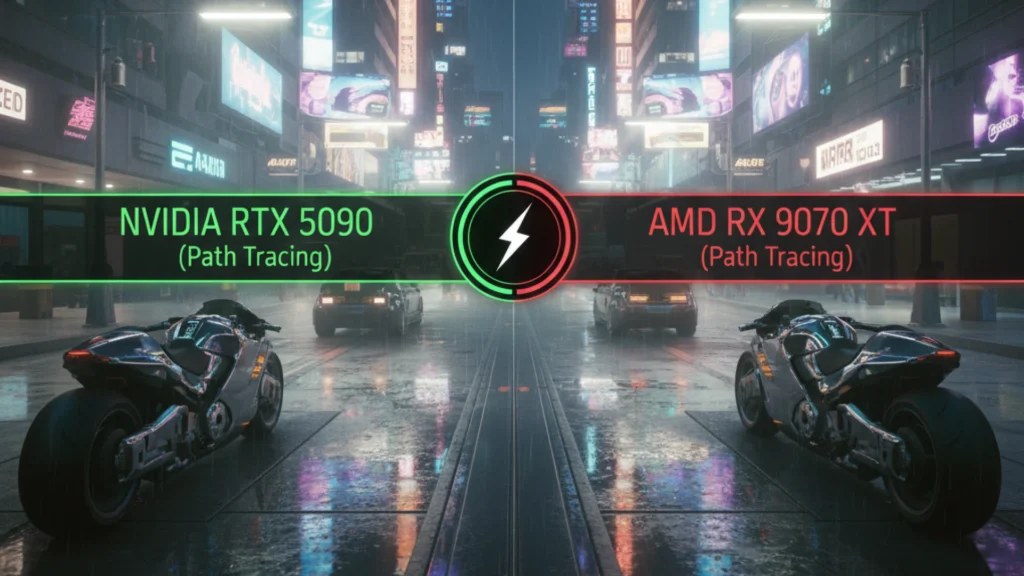
AI Acceleration and Upscaling Technologies: The Performance Multiplier
AI acceleration has revolutionized GPU performance, transforming how gamers experience demanding titles. AI upscaling technologies like NVIDIA’s DLSS 4 and AMD’s FSR 4 no longer simply boost frame rates; they fundamentally reshape the rendering pipeline, using machine learning to generate entire frames and reconstruct details that were never explicitly rendered. This battle between competing AI-driven approaches represents the future of gaming performance.
NVIDIA DLSS 4 – The Game Changer
NVIDIA’s DLSS 4 introduces Multi Frame Generation (MFG), an exclusive feature for the RTX 50 series that represents a paradigm shift in frame generation technology. While previous DLSS 3 Frame Generation created one additional frame between rendered frames, MFG can generate up to three additional frames from a single rendered frame. This revolutionary approach works in unison with the full DLSS suite to multiply performance by up to 8X (800%) over traditional rendering, enabling stunning 4K 240 FPS gaming in fully ray-traced worlds on a GeForce RTX 5090.
The magic behind MFG lies in a combination of Blackwell hardware and software innovations. A new, faster AI model for frame generation runs once per rendered frame to produce multiple frames, using 30% less VRAM and increasing performance by 10% in titles like Warhammer 40,000: Darktide. This is powered by the 5th-generation Tensor Cores in RTX 50 Series GPUs, which provide the necessary AI processing power to execute multiple AI models within milliseconds. Furthermore, a new hardware-based Flip Metering system in the Blackwell display engine ensures smooth and consistent frame pacing for the multiple generated frames.
Beyond MFG, DLSS 4 features a major architectural upgrade: a new transformer-based AI model for DLSS Ray Reconstruction, Super Resolution, and DLAA. This model uses a self-attention mechanism to evaluate the importance of each pixel across the entire frame, resulting in improved temporal stability, less ghosting, and higher detail in motion. This model is available for all GeForce RTX gamers and can be enabled via NVIDIA App overrides in a growing list of games, enhancing image quality beyond the previous convolutional neural network (CNN) model.
AMD FSR 4 & AI Capabilities – Leveling the Playing Field
AMD’s FSR 4 marks the company’s first fully AI-powered upscaler, representing a fundamental shift from the spatial and temporal techniques used in earlier versions. Leveraging the 2nd Gen AI Accelerators in RDNA 4 GPUs, FSR 4 uses machine learning models to intelligently reconstruct high-resolution images from lower-resolution inputs, finally bringing AMD’s upscaling technology into direct competition with NVIDIA’s AI-driven approach. Reviews note that FSR 4 delivers a significant step up in quality from FSR 3.1, with better sharpness, cleaner transparencies, and more stable images, often outperforming DLSS 3 and positioning itself between DLSS 3 and DLSS 4 in image quality.
What truly sets AMD’s implementation apart is the HYPR-RX suite, an ecosystem that combines FSR 4, Fluid Motion Frames 2.1 (AMD’s frame generation), Anti-Lag, and other features into a single one-click toggle in the AMD Software interface. This unified approach eliminates the complexity of enabling multiple technologies individually, making premium performance accessible to all users. The performance gains are dramatic: AMD demonstrates that in a title like Warhammer 40,000: Space Marine II, HYPR-RX can boost performance from 53 FPS at native 4K to 182 FPS, a 3.4x uplift. Similar dramatic gains are showcased across a wide range of games, making high-refresh-rate gaming viable on RDNA 4 hardware.
The Upscaling Verdict – Competition Breeds Innovation
The 2025 upscaling landscape is more competitive than ever. DLSS 4 unquestionably holds the ultimate performance crown, particularly with its exclusive Multi Frame Generation delivering unprecedented frame rate multipliers that are a definitive reason to invest in the RTX 50 series. Its new transformer model also provides a measurable lead in image quality, offering crisper details and superior stability that can sometimes even surpass native rendering.
However, FSR 4 within the HYPR-RX ecosystem represents a massive leap for AMD, transforming the company from an upscaling underdog to a legitimate competitor. The convenience of one-click activation and the dramatic performance gains make it an exceptional value proposition. While its frame generation currently focuses on single-frame interpolation rather than multi-frame generation, its image quality is now close enough that the difference is often difficult to perceive during actual gameplay.
The result is a highly competitive ecosystem where both platforms offer compelling AI acceleration solutions. NVIDIA pushes the boundaries of what’s possible with raw AI power and specialized hardware, while AMD delivers impressive, user-friendly performance that makes high-fidelity gaming more accessible. This intense rivalry ensures that gamers are the ultimate winners, benefiting from relentless innovation that continues to redefine visual computing.
Gaming Performance & Market Reality: Benchmarks Meet Budget
Gaming benchmarks tell the ultimate story of GPU capability, cutting through marketing hype to reveal real-world performance. The battle between NVIDIA’s RTX 50 series and AMD’s Radeon RX 9000 series plays out across different resolutions and price brackets, with each architecture claiming distinct advantages depending on your priorities and budget.
Rasterization Performance: Where Raw Power Meets Value
In pure rasterization performance, the RTX 5090 is the uncontested performance king. Independent testing confirms it leads all GPU gaming tests, showing a significant generational leap. At 4K Ultra settings, it delivers performance that is 25% faster on average than the previous-generation RTX 4090, making it the ultimate choice for no-compromise gaming.
However, raw performance doesn’t always translate to the best value. The Radeon RX 9060 XT 16GB has earned an “Editor’s Choice” award for its exceptional price-to-performance ratio, particularly at 1080p and 1440p resolutions. Its generous 16GB VRAM buffer provides crucial future-proofing, allowing it to handle modern games without the stutters that can affect cards with less memory.
For gamers targeting smooth 4K gaming, the Radeon RX 9070 XT hits a sweet spot. It is recognized as the best value for achieving a solid 60 FPS experience at native 4K without relying on upscaling technologies. While it doesn’t match the raw horsepower of the more expensive RTX 5080, its performance is close to the GeForce RTX 5070 Ti in traditional rendering, offering legitimate 4K capability for a more accessible price.
Market Positioning & Pricing: The Reality Check
The theoretical world of MSRPs has collided with the reality of market dynamics in 2025. AMD’s suggested prices for the RX 9070 and 9070 XT are now seen as having been “unduly optimistic” at launch, with street prices settling higher. Despite this, these cards still offer fair performance-per-dollar relative to their NVIDIA competitors, making them a sensible value proposition.
The situation is more extreme on the high end. NVIDIA enjoys unchallenged dominance, and its flagship cards remain significantly marked up. The RTX 5080 is still selling for well above its $999 MSRP, and the RTX 5090’s official $1,999 price tag is largely theoretical, with actual prices consistently hovering around $2,500 or more. This makes them exotic purchases for those with virtually unlimited budgets.
Use Case Recommendations
Matching the right GPU to your primary gaming style is key to maximizing satisfaction and value. The following table summarizes the ideal choices for different user profiles:
| Use Case | Recommended GPU | Key Rationale |
|---|---|---|
| Competitive/High-Refresh Gaming | AMD Radeon RX 9060 XT 16GB or NVIDIA GeForce RTX 5060 series | Excellent high-frame-rate performance at 1080p/1440p; choice depends on budget and brand preference for low-latency tech. |
| 4K Ray Tracing Enthusiasts | NVIDIA GeForce RTX 50 Series (RTX 5070 Ti and above) | Definitive choice for path tracing; 4th-gen RT Cores and DLSS 4 with Multi Frame Generation enable playable frame rates in demanding RT titles. |
| 1440p Value Seekers | AMD Radeon RX 9000 series (RX 9070 & RX 9060 XT) | The sweet spot for performance-per-dollar; excellent 1440p rasterization, improved RT, and 16GB VRAM provide a fantastic, future-proofed experience. |
Ultimately, your choice in the 2025 GPU market depends on whether your priority is ultimate performance regardless of cost or the smartest performance for your dollar. For the former, NVIDIA’s RTX 5090 reigns supreme. For the latter, AMD’s Radeon RX 9000 series presents a compelling and highly competitive alternative.
Memory, Power & Technical Specs: The Foundation of Performance
The memory subsystem represents the lifeblood of modern GPU performance, determining how quickly data flows between the processor and VRAM. NVIDIA and AMD have adopted contrasting philosophies for their latest architectures, each offering distinct advantages that impact real-world gaming performance and longevity.
Memory Architecture: Speed vs. Efficiency
NVIDIA’s Blackwell architecture leverages cutting-edge GDDR7 memory, delivering a generational leap in memory bandwidth to feed its computational units. GDDR7 achieves this through several key innovations, including PAM3 signaling, which allows it to transmit 50% more data per clock cycle than the NRZ signaling used in GDDR6. Initial implementations, like that in the RTX 5080 with 30 Gbps memory on a 256-bit memory bus width, demonstrate a massive jump to 960 GB/s of bandwidth, a significant increase over its predecessor using GDDR6X. This raw bandwidth advantage is crucial for data-intensive tasks like 4K gaming with heavy ray tracing.
In contrast, AMD’s RDNA 4 architecture employs a refined strategy centered on efficiency. It continues to use mature GDDR6 technology, with its top “Navi 48” chip expected to use a 256-bit bus with 20 Gbps memory for 640 GB/s of raw bandwidth. To bridge the bandwidth gap, AMD relies on its Infinity Cache technology. This large, on-package cache acts as a high-speed buffer, dramatically reducing the need to access the slower main memory. This architecture delivers highly effective bandwidth while leveraging a cost-effective and power-efficient memory solution.
VRAM Capacity: Future-Proofing Your Investment
AMD’s strategy of generous VRAM capacity allocations represents a significant advantage for longevity-focused gamers. A configuration like a 16GB graphics card on a mid-range model provides exceptional headroom for modern titles. As game texture quality and asset streaming demands continue to escalate, having ample VRAM prevents stuttering and performance degradation at high resolutions.
This substantial VRAM capacity ensures smooth performance as game developers increasingly target next-generation consoles with large, unified memory pools. For users who engage in content creation alongside gaming, such as video editing or 3D rendering, generous VRAM allocations help eliminate memory bottlenecks that severely impact performance on lower-capacity cards.
NVIDIA’s approach with GDDR7 memory offers superior bandwidth, which can partially mitigate the need for larger VRAM quantities in some scenarios. However, in situations where a game or application explicitly requires a large frame buffer, AMD’s more generous standard allocations provide clear future-proofing benefits. The following table summarizes the key differences in their memory philosophies:
| Feature | NVIDIA RTX 50 Series (Blackwell) | AMD RDNA 4 (RX 9000 Series) |
|---|---|---|
| Memory Technology | GDDR7 | GDDR6 (complemented by Infinity Cache) |
| Key Innovation | PAM3 signaling for ultra-high bandwidth (e.g., 30 Gbps on RTX 5080) | Large Infinity Cache to boost effective bandwidth and efficiency |
| Primary Advantage | Unprecedented raw bandwidth for maximum performance | Cost-effective and power-efficient design with strong effective performance |
| VRAM Strategy | Varied, with high capacity on flagships (e.g., 32GB on RTX 5090) | Generous allocations (e.g., 16GB on mid-range models) for future-proofing |
Power Efficiency & Thermal Performance: Watts, Heat, and Reality
GPU power consumption has become a critical consideration for modern gaming builds, impacting everything from electricity costs to cooling requirements and system noise levels. The TDP comparison between NVIDIA’s Blackwell and AMD’s RDNA 4 architectures reveals contrasting design philosophies that significantly affect real-world ownership experiences and energy efficiency.
Power Draw Reality: Performance Comes at a Price
NVIDIA’s flagship RTX 5090 represents the pinnacle of performance and power consumption. With a rated TDP of 575W, real-world testing shows its average power draw can reach high levels during demanding 4K gaming, a significant increase over the previous generation. This necessitates a robust power supply. The thermal design must handle this substantial heat output, which is why most aftermarket models feature triple-fan configurations and massive heatsinks.
In contrast, AMD’s RDNA 4 architecture demonstrates superior energy efficiency across its product stack. The RX 9070 XT maintains competitive performance with a TDP in the 220-225W range, making it compatible with quality 650W-750W power supplies that many gamers already own. AMD’s strategy with RDNA 4 focuses on delivering strong performance while leveraging a cost-effective and power-efficient design.
Performance Per Watt: The Efficiency Crown
When evaluating performance per watt, AMD’s architectural improvements shine. AMD has made notable gains in power efficiency with its RDNA 4 architecture. One of the standout cards for efficiency is the AMD RX 9070, which in some tests nearly tied for the most efficient GPU on the market, hitting a “sweet spot” of power and performance. This efficiency translates directly to lower cooling requirements. Many models can utilize effective dual-fan designs that remain remarkably quiet even under sustained load.
The cooling requirements disparity becomes evident in system builds. NVIDIA’s high-end cards often demand case modifications, upgraded airflow configurations, or premium cooling solutions to maintain optimal temperatures. AMD’s cards, with their lower thermal design power, generally operate comfortably with standard tower coolers and basic case ventilation, reducing both initial build costs and long-term operating expenses.
For gamers in warm climates or those concerned about electricity costs, RDNA 4’s superior energy efficiency represents tangible value. The difference between a 225W and a 575W GPU accumulates to dozens of kilowatt-hours monthly, translating to noticeable utility bill savings over the card’s lifespan. Additionally, a lower thermal design power means less ambient heat in your gaming space, a significant quality-of-life consideration.
Beyond Gaming: Creative & AI Workloads
While gaming performance dominates GPU discussions, the explosion of generative AI and content creation workflows has transformed graphics cards into essential tools for creators, developers, and professionals. The capabilities of modern GPUs extend far beyond frame rates, as choosing between architectures is increasingly dependent on specific professional workload requirements and software ecosystems.
NVIDIA’s Professional Dominance
NVIDIA maintains an overwhelming advantage in creative and AI workloads through its mature CUDA ecosystem and comprehensive software platform. This combination of optimized drivers, exclusive AI-powered applications, and extensive software partnerships makes RTX 50 series cards the default choice for serious work. Applications across the creative spectrum, from 3D rendering in Blender and Autodesk Arnold to video editing in DaVinci Resolve and Adobe Premiere Pro, are heavily accelerated by NVIDIA hardware, delivering rendering and export speeds that are often significantly faster.
The AI PC revolution has further cemented NVIDIA’s position as the definitive platform for local generative AI. The ecosystem for running large language models (LLMs) and AI image generation tools is deeply optimized for NVIDIA GPUs through frameworks like TensorFlow and PyTorch. For productivity users and creators, NVIDIA’s CUDA cores and widespread software ecosystem support continue to give it the edge in compute-heavy tasks like 3D rendering, AI, and simulation.
AMD’s Evolving Creative Proposition
AMD has made genuine progress in this space with the dedicated AI Accelerators in its RDNA 4 architecture and the continued development of its open software platform. For certain workloads, particularly in applications that support hardware-agnostic APIs or AMD’s HIP backend, RDNA 4 can deliver competitive performance. The company has also improved its support for popular AI frameworks and models, expanding its capability for machine learning development. AMD is also planning to deliver enhanced media encoding and AI capabilities, thanks to dedicated hardware that we haven’t seen previously on its earlier architectures.
However, a software maturity gap remains AMD’s primary challenge in professional markets. Many industry-standard creative applications are built around NVIDIA’s CUDA architecture from the ground up, offering features and optimizations that are often unavailable or perform less consistently on AMD hardware. While AMD’s compute ecosystem for OpenCL and HIP is improving, it still has less industry adoption compared to NVIDIA’s CUDA and TensorRT platforms. For professionals whose productivity depends on reliability and broad compatibility, NVIDIA’s proven and deeply integrated ecosystem continues to offer a compelling advantage.
Price-to-Performance & Final Verdict: Choosing Your Champion
After extensive analysis of architectures, benchmarks, and real-world performance, the ultimate question remains: which GPU offers the best value for your specific needs? The answer in 2025 depends entirely on your priorities, budget, and intended use cases. Both NVIDIA’s RTX 50 series and AMD’s RDNA 4 lineup offer compelling arguments, but they excel in distinctly different areas of the GPU value 2025 landscape.
Performance Per Dollar: The Value Equation
GPU value 2025 has become increasingly complex as both manufacturers push technological boundaries while navigating market realities. A direct price comparison reveals significant disparities between MSRP and actual retail availability. The RTX 5090’s theoretical $1,999 price point has been difficult to find, with real-world costs frequently elevated, which impacts its final performance per dollar calculation. Similarly, AMD’s suggested prices for the RX 9070 and RX 9070 XT were initially optimistic, with street prices settling higher, though they still offer fair performance-per-dollar relative to the competition.
The best value GPU crown for mid-range gaming arguably belongs to the Radeon RX 9060 XT 16GB, an “Editor’s Choice” winner that provides exceptional 1440p performance, generous VRAM, and strong power efficiency at a price point accessible to mainstream gamers. For budget gaming GPU considerations under $300, the NVIDIA RTX 5060 also presents a strong case, leveraging its GDDR7 memory and DLSS 4 support.
The RX 9070 XT occupies a critical enthusiast sweet spot, delivering legitimate 4K gaming capability at prices that undercut NVIDIA’s comparable RTX 5070 Ti while matching its VRAM capacity. For gamers prioritizing native resolution performance without relying exclusively on upscaling technologies, AMD’s value proposition is strong.
Choose NVIDIA RTX 50 Series If:
- You demand the absolute best ray tracing and path tracing performance. The 4th-gen RT Cores deliver unmatched capability in demanding titles with full ray tracing effects.
- You want cutting-edge AI features, specifically DLSS 4 with Multi Frame Generation (MFG). This exclusive feature for RTX 50-series cards can generate multiple AI frames from a single rendered one, offering a transformative performance boost in supported titles and justifying the premium for high-refresh-rate gaming enthusiasts.
- You’re a content creator or developer leveraging NVIDIA’s mature AI and CUDA ecosystem. The combination of CUDA acceleration, Studio drivers, and first-class software support across professional applications makes RTX 50 series cards essential tools for creative professionals.
Choose AMD RDNA 4 If:
- You prioritize exceptional value and performance-per-dollar. AMD delivers competitive gaming performance, often beating similarly priced Nvidia cards in raw rasterization, making high-end gaming experiences accessible without extreme budgets.
- You want strong rasterization performance with now-viable ray tracing. RDNA 4’s 3rd-generation Raytracing Accelerators, which double the throughput per compute unit compared to the previous generation, transform AMD from a ray tracing afterthought to a legitimate option for gamers who want beautiful lighting without paying NVIDIA premiums.
- You value a power-efficient design and lower operating costs. Models like the RX 9070 feature a 220W TGP, which translates to quieter systems, smaller cooling requirements, and tangible electricity savings over the GPU’s lifespan compared to many competing NVIDIA models.
The Verdict: Two Champions, Different Crowns
NVIDIA emerges as the “Feature & Performance King,” offering unassailable leadership in ray tracing, AI acceleration with DLSS 4 MFG, and professional workloads. For enthusiasts who demand the absolute best regardless of cost, the RTX 50 series delivers unmatched capabilities.
AMD claims the “Value Champion” title, providing exceptional performance-per-dollar that democratizes high-end gaming. For pragmatic gamers seeking maximum frame rates and future-proofing VRAM within realistic budgets, RDNA 4 represents the smarter investment, often delivering a superior gaming experience for the money.
FAQ Section: Your Graphics Card Buying Questions Answered
Navigating the GPU comparison FAQ landscape can be overwhelming with so much technical information to process. Here are the most common graphics card buying questions about the RTX 50 series and AMD RDNA 4 FAQ topics, answered concisely based on our comprehensive analysis.
Which GPU has better ray tracing performance?
NVIDIA leads definitively in ray tracing, particularly in demanding path-tracing scenarios, thanks to its 4th-generation RT Cores. However, AMD has dramatically improved its credentials, with RDNA 4’s new Ray Accelerators delivering a generational leap in intersection test performance, making it a truly viable option for gamers who want quality ray tracing without paying NVIDIA’s premium. For hybrid rendering with selective ray tracing effects, the performance gap narrows considerably.
Is DLSS 4 better than FSR 4?
DLSS 4 has a clear feature lead with its exclusive Multi-Frame Generation (MFG), which can generate multiple AI frames from a single rendered one for massive performance boosts. This is powered by the 5th-gen Tensor Cores in RTX 50-series GPUs. FSR 4, AMD’s first AI-powered upscaler, is a major leap forward and is integrated into the convenient HYPR-RX suite for one-click activation and massive FPS gains. While DLSS 4 often holds an edge in image quality, FSR 4 is highly competitive.
Which GPU offers the best value for gaming?
For 1440p and 4K value gaming, AMD’s offerings are top contenders. The Radeon RX 9060 XT 16GB has earned an “Editor’s Choice” award for its exceptional price-to-performance ratio and future-proofing thanks to its generous VRAM. The Radeon RX 9070 XT is also recognized as a well-rounded card that delivers strong performance for its cost, making it a great value for enthusiasts. For the absolute best performance regardless of cost, the NVIDIA RTX 5090 is the leader.
How much power supply do I need for these GPUs?
Power requirements vary significantly. The flagship RTX 5090 has a high TDP, with NVIDIA recommending a 1000W PSU for systems using this GPU. In contrast, AMD’s RDNA 4 architecture is generally more power-efficient. The RX 9070 XT has a TDP of 225W, and the RX 9070 has a TGP of 220W, making them compatible with lower-wattage, quality 650W-750W PSUs. Always check the specific power recommendations for your chosen model.
Which is better for content creation and AI work?
NVIDIA dominates content creation and AI work through its mature CUDA ecosystem and NVIDIA Studio platform, which are widely supported in professional applications. For running local generative AI models and in AI-powered creative software features, NVIDIA’s Tensor Cores and extensive software optimization make RTX 50 series cards the definitive choice. AMD has made progress with its ROCm platform, but the software maturity gap remains.
Will these GPUs work with my existing setup?
Check three key factors for compatibility:
PSU: Ensure your power supply has sufficient wattage and the correct PCIe power connectors.
Physical Size: High-end cards, especially the RTX 5090, are large. Measure your case’s clearance to ensure the card will fit.
Motherboard: Both architectures are compatible with the PCIe 5.0 interface but remain fully backward compatible with PCIe 4.0 and 3.0 motherboards.
